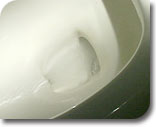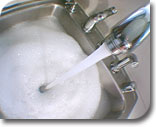|
...in your pipes
Periodically,
check your plumbing fixtures and exposed pipes. Listen for the sound of
running water - many leaks can be detected by sound as well as by sight.
Even if you cannot hear or see a leak, close all water outlets (faucets
and taps) and check your meter just to be on the safe side.
... in your toilet
 Pay
close attention to your toilet plumbing, where leaks are often hardest
to detect. A quick check can be made by placing a few drops of food
coloring into the tank after it has filled and quieted, and watching for
its appearance in the bowl. If there is a leak, then color should appear
within 5-10 minutes. Even if no leak is detected, the test should be
repeated, as such leaks are often intermittent. The Department of
Water also has dye tablets for detecting toilet leaks available by
contacting our Public Relations Specialists at 245-5461. Pay
close attention to your toilet plumbing, where leaks are often hardest
to detect. A quick check can be made by placing a few drops of food
coloring into the tank after it has filled and quieted, and watching for
its appearance in the bowl. If there is a leak, then color should appear
within 5-10 minutes. Even if no leak is detected, the test should be
repeated, as such leaks are often intermittent. The Department of
Water also has dye tablets for detecting toilet leaks available by
contacting our Public Relations Specialists at 245-5461.
 ...
in your faucet ...
in your faucet
Perhaps the most common cause of water waste is
the leaky faucet. Because a dripping faucet deceptively appears to be
letting out very small amounts of water, this problem is often
neglected. Yet a leaking drip that is 1/32nd of an inch wastes 25
gallons in 24 hours; one that is 1/16" wastes 100 gallons in 24 hours;
and a stream of 1/8" wastes 400 gallons in a 24-hour period.
Check faucets regularly for leaks at the faucet head and seepage at
the base and its connections. When a leaking faucet is found, no matter
how small the leak appears to be, it may be time to replace a worn
washer, which is something homeowners themselves can fix. The
replacement of a simple rubber ring like this can save untold dollars in
wasted water.
... in your yard
Automatic
sprinkler systems make lawn irrigation easy. However, these
timesaving devices are also susceptible to leaks! Irrigation
system leaks are not always noticeable, so it is important to check the
sprinkler timer, connections and heads for signs of a leak. Wet or
noticeably greener spots of grass near a water sprinkler could indicate
a sprinkler in need of repair. A properly maintained irrigation
system will help keep your yard healthy and save water.
When you go away...
If you must
leave your home empty for any length of time - on vacation, for instance
- it might be a good idea to shut off your water valve so that if a
serious leak develops while you're away, it will not flood the premises
or run up a large water bill for you.
The shutoff or property valve is usually located inside your
property, a few feet from the water meter. If a fixture or a pipe is
damaged, your first move should be to shut off the supply using this
valve. It's most important to keep the shutoff valve clear and within
easy access, and in good working order at all times.
|

